Mother Nature can halt 475-HP Durango
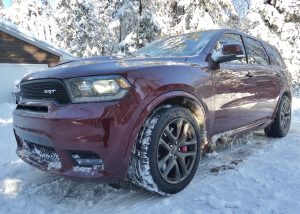
A 475-horsepower 6.4-liter Hemi makes the 2020 Durango SRT go through everything — except , maybe, a 29-inch blizzard.
By John Gilbert
In ordinary circumstances, getting the chance to test-drive a new Dodge Durango SRT would be a fun, light-hearted adventure — big SUV, macho look from every angle, a look supported by SRT suspension, interior, wheels and engine. Especially the engine.
We’re talking Dodge’s legendary 6.4-liter Hemi V8, basically the same engine that powers the overpowering Charger and Challenger members of Dodge’s hot-rod car collection. In the Durango, the engine is detuned a bit, by losing the supercharger and configured to send power to all four wheels in its all-wheel-drive layout. Calling it detuned seems unfair, unless you’ve driven the supercharged Hellcats, because nearly 500 horsepower is nothing to growl at.
The Durango still gets tuning from the SRT specialists, and it hits the road with 475 horsepower and 470 foot-pounds of torque. As you can imagine, that sort of power sends the Durango off and running with the power of a sports sedan, and the thrust of a dragster.
Going back to my original premise, though, it would have been just fun and roaring under ordinary circumstances, but on Thanksgiving week in Duluth, Minnesota, there was nothing ordinary about anything. First came an 8-inch snowfall, in the form of a blizzard blown by winds off Lake Superior. Two days later, the “big” storm hit. This one started off in Southern California and carved a wide but artistic swath across the Midwest, finally reaching its target at Lake Superior. The swirling winds hit 58 mph, and the city got an official 22 inches of snow. Out on the ridge overlooking the North Shore, where we live, we got just a shade under 29 inches from that storm.
This was heavy, moist snow — not the kind that makes for good snowballs, or snowmen, but the kind that feels that each shovelful might break the shaft of the shovel. As it turned out, we were about to venture out after that storm to drive our niece to the Duluth Airport for a 5 a.m. flight, which was delayed to 6 a.m., then 8 a.m., then cancelled, with her trip back home to New York switched to United via Chicago. We were ready to go, because I was going to be behind the wheel of the Durango, and churning through any snowpile we might find would be exciting.
Wrong.
I barreled out through bumper-deep snow in our 100-yard driveway, up and over the outer lip and onto the rural road that runs straight south to the Lake, two miles away. But as soon as I got to the road itself and completed my left turn, the big and powerful Durango was brought to a halt right in the middle of the road. I tried to back up, we just spun. I tried to lurch forward, no go. Fortunately, at 6 a.m. on that Sunday morning, there no other folks were out trying to drive. I slogged back to the house and returned with two shovels, and my wife, Joan, and I went to work.
With no passes having been made by a County plow, the 29 inches made a formidable cover over the entire road. We had pushed enough snow ahead of us as we exited our driveway that it all compressed into a virtual wall that was solid enough to stop us, right in our tracks, with snow halfway up the stylish black grille. The ever-aware electronic sensors notified us that the front sensor was obscured. No kidding. It also warned us of an imminent crash on our right front, but it was only that compressed snow that our sensors mistook for a wall. For most of an hour, we shoveled snow from under the front and rear of the Durango, and from both sides of each wheel, as well as under the vehicle.
I went back to the driver-assist segment of the diagnostic screen, and after looking over 20 or 30 possible settings, I spotted one, next to last, that said, “snow.” I clicked it. Not sure if it made any difference, probably only starting us up in second gear, but it gave me a dose of confidence, and I finally was able to coax the big beast, by gently rocking forward and back a dozen times, and we edged ahead. Once we got a tiny bit of momentum I was happy we were on top of the hill, heading down.
The wonderfulness of all the bucket seat comfort and gadfgetry — including dragstrip launch control for the heavy-duty 8-speed automatic — was relegated to the back burner as we drove the two miles, with total whiteout conditions giving us no idea of where either side of the road might be. When I got down to the freeway, nobody was coming and I pulled out confidently, because surely the freeway that now makes up Hwy. 61 would be plowed.
Wrong again. I pulled out to where the lane should be and turned right, and spun 90 degrees, coming to rest sideways. Again, with nobody coming, I calmly straightened out and advanced, realizing that a freezing drizzle that hit first had formed a smooth and slick coating under those 2 feet of snow.
There had been no plows reaching any streets except maybe four main ones, and I guessed right about which ones they might be as I climbed the hill and headed for the Duluth airport. We got there at 8 a.m. and were not surprised that the 8:05 flight had not left, because it had been cancelled. At least we could get breakfast before the 10:50 flight. Wrong again. Nobody who worked at the Duluth Airport restaurant had made it to work. Nor had anyone made it to operate the Delta desk.
Since our niece’s flight had been cancelled, Delta had rebooked her on a United flight to Chicago and then LaGuardia — but that flight was also cancelled. As the line lengthened at the United counter, a nice young woman wearing the weather-proof suit of a gate attendant came by and said she would try to help people get rebooked via Delta. Her name was Elena, although I can’t be sure of the spelling. I’ve had some excellent service from desk folks at Delta at the Duluth Airport, but never one as accommodating, friendly, and effective as Elena, who managed the magical rebooking, and got the change-of-carrier fee waived as well.
So our niece was on her way, with no further adventure. We, however, had to get back home, after trying unsuccessfully to find any of our favorite breakfast places that might be open. We were 0-for-6 before we called the Boat House in Fitger’s Hotel. Great spot, and they were open. We got home and I parked the beautiful metallic red Durango by our mailbox, out on the road.
Our other project to complete before all that on Thanksgiving Weekend was to get our son, Jack, on his way back to the Twin Cities. We had gotten him a good pair of tires to put on the front of his Mazda6, but we hadn’t been able to find anyplace that would mount them, and we didn’t want him to drive back on the old tires. That, however, is a separate story by itself.
Our test-drive Durango began life at $62,995, but loaded up with all the high-end features that an SRT commands, the sticker was $73,060. It did handle all the marginal tunnels that used to be streets for the next few days, just as it had breezed through all the pre-snowstorm driving, which showed off its impressive stability and handling devices were outstanding, including the steering wheel paddles allowing manual control of the 8-speed.
The know-all sensors and computer stuff went beyond the norm. For example, at one point, a note flashed onto the screen where the audio and phone records had been and it notified us that a blizzard warning had been issued for Lake and St. Louis counties. We’re in St. Louis County, and such tips are invaluable, considering how many strange twists and turns of weather can occur near the big lake. We were just unprepared fir getting the notification from our vehicle.
By the time our venture through the the big snowstorm ended, and the big plows came by on our road, our neighbor, Greg, had saved us from what would have been a half-day of shoveling. Greg has a snow-blower and an all-terrain vehicle with a plow, and he is an artist with both. And he used both, one to do the preliminary work and the other to polish it off.
If the Durango has almost everything, my only suggestion might be for Dodge to add a plow. That would only make it a fair fight, because we could have blasted our way out of the driveway and down the road with 475 horsepower plowing 29 inches of snow in all directions.
PERFECT TIMING, PERFECT NAME
Meanwhile, back to our other storm-weekend task. A lot of service outlets in the Duluth area were closed for the Thanksgiving holiday, and on through Friday and the long weekend, and I can’t blame them. Those that weren’t closed, did close after the big snowstorm hit us. Finding a shop where we could get our two nearly-new Goodyear allseason tires mounted for our older son, Jack, was like a perfect holiday story that he couldn’t find anyone at a shop capable of mounting them on his wheels.
If this was a movie, we would now need a flashback, to several years ago, out in Los Angeles, where a fellow named Donnell Kelly decided to move his family to accommodate his real estate business. Somehow, after a stop or two along the way, he somehow found is way to Duluth. He decided to open a service outlet in West Duluth, way out on 69th Avenue West and Grand Avenue, near the Duluth Zoo. It’s not a fancy place, and he named it “Good Timing.” That’s a great name for a place that tunes engines — setting the timing just right — and does everything else, too, from engine tuneups to overhauls. On social media, numerous customers had given the place glowing reviews.
We called, and Donnell said he was extremely busy, but he’d mount the tires if we could leave the Mazda6 there for a few hours. We drove the required 25 miles to get there and found a basic, simple shop, and a lot lined with cars. A lot of cars could mean slow service, but slow service leaves you with few, if any, customers. A lot of cars means you do good work, which attracts more customers seeking good work at reasonable prices.
Donnell was in the office, down at the end of the place. He told me he does honest work, and knows that sometimes people come through traveling and are desperate to get work done and be on their way. That’s the way it is with tires, too, he said. When people need tires mounted, it’s not a big profit thing, but he knows it usually means desperation for someone on a trip, so he stays open past his 5 p.m. closing time so his five-man crew can accommodate those people.
“I tell people what their car needs, and that’s what I do,” he said. “I’m honest, and that means I can go home and sleep soundly every night, because I know we’ve done an honest day’s work. We close at 5, but if I tell someone we’ll get it done, we’ll stay as long as we have to to get it done.”
We came back at 5 and got Jack’s Mazda6, and the next day, he was all set to drive to the Twin Cities, on the Saturday when the storm started and then hit in full fury. Jack drove southward about 25 miles and turned around at Cloquet to come back to our home on the North Shore. We worried because it took him about an hour and a half to get back. Turns out, he stopped to help a fellow who had driven off Interstate 35’s whiteout shoulder.
That’s my kid. Always willing to help someone who needs it. Maybe Donnell could use another honest, good samaritan.



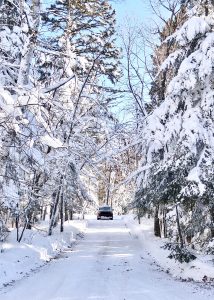
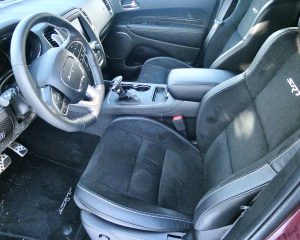
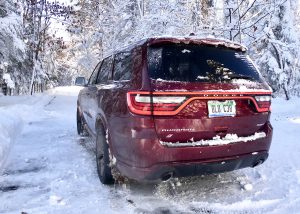
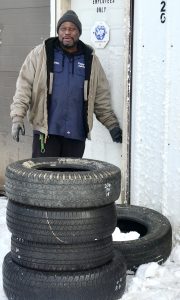
 John Gilbert is a lifetime Minnesotan and career journalist, specializing in cars and sports during and since spending 30 years at the Minneapolis Tribune, now the Star Tribune. More recently, he has continued translating the high-tech world of autos and sharing his passionate insights as a freelance writer/photographer/broadcaster. A member of the prestigious North American Car and Truck of the Year jury since 1993. John can be heard Monday-Friday from 9-11am on 610 KDAL(www.kdal610.com) on the "John Gilbert Show," and writes a column in the Duluth Reader.
John Gilbert is a lifetime Minnesotan and career journalist, specializing in cars and sports during and since spending 30 years at the Minneapolis Tribune, now the Star Tribune. More recently, he has continued translating the high-tech world of autos and sharing his passionate insights as a freelance writer/photographer/broadcaster. A member of the prestigious North American Car and Truck of the Year jury since 1993. John can be heard Monday-Friday from 9-11am on 610 KDAL(www.kdal610.com) on the "John Gilbert Show," and writes a column in the Duluth Reader.